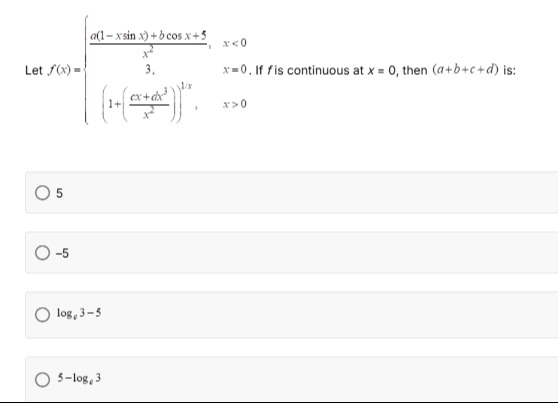Question
Question: Let $$ f(x) = \begin{cases} \frac{a(1-x\sin x)+b\cos x+5}{x^2}, & x<0 \\ 3, & x=0. \\ \left(1+\left(...
Let
f(x)=⎩⎨⎧x2a(1−xsinx)+bcosx+5,3,(1+(x2cx+dx3))1/x,x<0x=0.x>0If f is continuous at x=0, then (a+b+c+d) is:

ln3−5
5−ln3
−5+ln3
−5−ln3
ln3−5
Solution
For the function f(x) to be continuous at x=0, the left-hand limit, the right-hand limit, and the function value at x=0 must be equal. We are given f(0)=3.
1. Left-hand limit: limx→0−f(x)=limx→0−x2a(1−xsinx)+bcosx+5 For the limit to be finite, the numerator must approach 0 as x→0. As x→0, a(1−xsinx)+bcosx+5→a(1−0)+b(1)+5=a+b+5. So, we must have a+b+5=0, which implies a+b=−5.
Using Taylor series expansions: sinx≈x and cosx≈1−2x2. Numerator ≈a(1−x2)+b(1−2x2)+5=(a+b+5)−(a+2b)x2. Since a+b+5=0, the numerator is −(a+2b)x2. The left-hand limit is: limx→0−x2−(a+2b)x2=−(a+2b) For continuity, −(a+2b)=3, which means a+2b=−3.
Solving the system:
- a+b=−5
- a+2b=−3 Subtracting (2) from (1): 2b=−2⟹b=−4. Substituting b=−4 into (1): a−4=−5⟹a=−1.
2. Right-hand limit: limx→0+f(x)=limx→0+(1+(x2cx+dx3))1/x=limx→0+(1+xc+dx)1/x For the limit to be finite, we must have c=0. The limit becomes limx→0+(1+dx)1/x. This is of the form 1∞. Using the standard limit limx→0(1+kx)1/x=ek, we get ed.
For continuity, ed=3, so d=ln3.
3. Sum of coefficients: a=−1, b=−4, c=0, d=ln3. a+b+c+d=−1+(−4)+0+ln3=−5+ln3.
